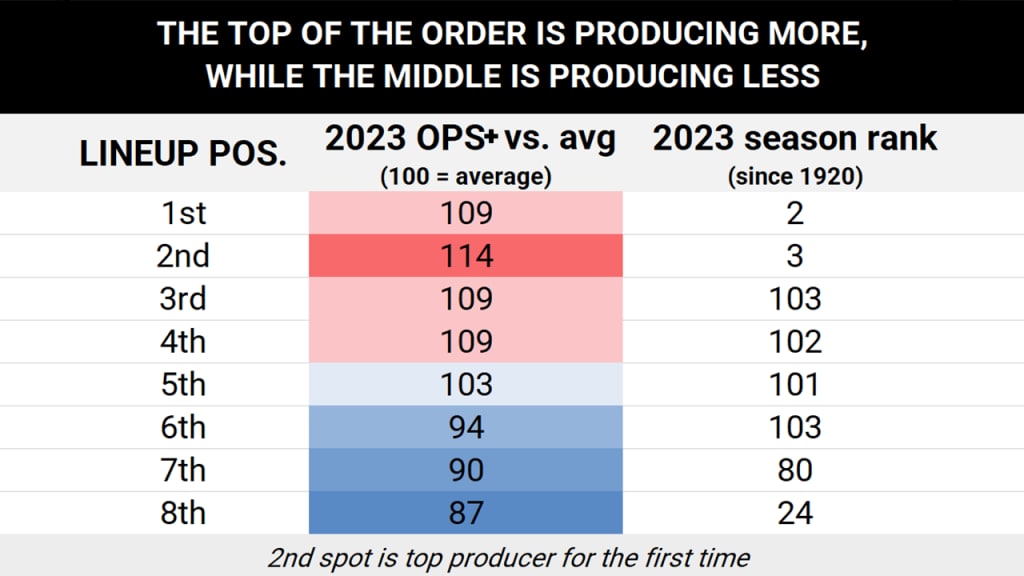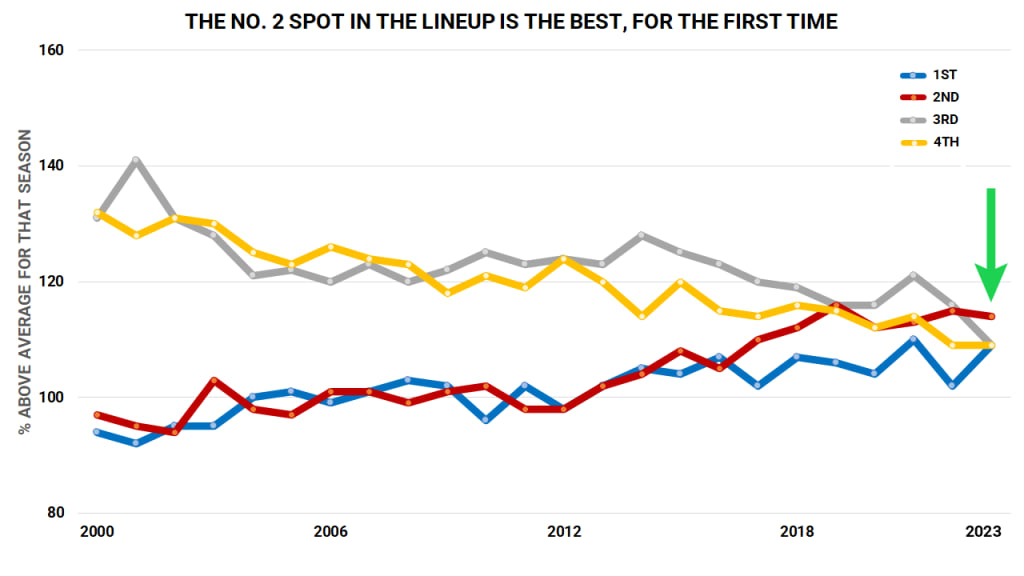If Babe Ruth were starring for the Yankees today, he might not be wearing his legendary No. 3, famously issued to him when the team first put uniform numbers on their backs in 1929 simply because that¡¯s where he had primarily batted in the lineup: third. Instead, imagine a world in which the number retired for the Babe out in Monument Park is the one you currently associate with Derek Jeter: No. 2.
Now batting, number two, Babe Ruth. Number two.
Why? Because lineups simply aren¡¯t constructed the same way they were back in Babe¡¯s day, when it was mainly: ¡°Put the fastest hitter at the top, the good bat control guy second, and your best hitters third and fourth,¡± no matter whether those first two hitters could actually hit, or even get on base. Instead, the trend over the last decade has been about getting your best hitters as many plate appearances as you can, as often as you can, which means not putting lesser hitters in front of better hitters.
It means great hitters bat first. It means great hitters bat second, too.
Simply look around the sport today and see how lineups are put together. Ronald Acu?a Jr. hits leadoff. So does Mookie Betts, and Christian Yelich, and Kyle Schwarber, and George Springer, and Adley Rutschman. Freddie Freeman hits second, just like Mike Trout, Aaron Judge, Corey Seager and Paul Goldschmidt. Julio Rodr¨ªguez and Shohei Ohtani have bounced between the top two spots. If he played today, you might just have seen the Babe hitting second, too.
If the trend has accelerated over the last decade, and it has, then it¡¯s truly reached a tipping point in 2023.
For the first time in the Live Ball Era of AL/NL baseball (since 1920), the second spot in the order is more productive on a relative basis than the third spot. That actually undersells it; for the first time in that history, the second spot is the most productive spot in the order. Also for the first time, the leadoff spot is as productive as the cleanup spot. It¡¯s the culmination of a recent trend ¨C if you combine the top two spots in the order, then five of the top six seasons for 1-2 production are the past five seasons.
If you want to find the best hitters in the sport, look at the top of the lineup. Now, more than ever before.
Now batting, number two, Babe Ruth. Number two.

So: How did we get here?
While Earl Weaver, a manager ahead of his time, had written about how important on-base ability was at the top of the lineup in his 1984 book "Weaver on Strategy," for the most part, very little had changed between Ruth's time and, say, Miguel Cabrera's.
In 2006, analyst Tom Tango (now at MLB) and a pair of co-authors had written "The Book," which convincingly posited that batting order doesn¡¯t actually make as much difference as you¡¯d think. But, that what little value you could gain from it argued that the leadoff spot required on-base skills more than speed, and that the No. 2 spot required all-around skill more than bat control, since it came up in situations just as valuable (or more so) than the No. 3 spot, but more often.
The idea took time to catch on. As recently as 2008, The Hardball Times featured a post that said ¡°the second spot in the batting order is almost certainly the one most frequently mishandled by managers, and they¡¯ve been repeating the same fundamental error over and over since 1920.¡± It¡¯s not that good hitters had never hit second before, but when they had, it was often examples such as Frank Robinson, Eddie Mathews and Alex Rodriguez, who sometimes hit No. 2 early in their careers before being moved to more "traditional" power spots.
That year, 2008, was representative of the first century of lineup construction, as the No. 2 spot had the lowest OPS (.742) of any of the first six positions in the order ¨C despite being given 2.5% more plate appearances than the third spot and 10% more than the sixth spot. You could have said the same thing about 1968, in terms of the two-spot being the weakest of the top six. You could have said the same thing about 1928, too. Extremely little had changed, and it wouldn¡¯t for years. In early 2013, writing at Baseball Prospectus, Sam Miller said that ¡°there¡¯s not only been no lineup revolution; there¡¯s been no real lineup movement.¡±
He was right. There had overwhelmingly been little movement at all. Until there was.
***
Over the 20 seasons from 1993 through 2012, the first three spots in the lineup looked like this, comparing the OPS out of each spot to the rest of the lineup.
- 1st: 2% below average
- 2nd: 1% below average
- 3rd: 26% above average?
- 4th: 25% above average
In 2013, you finally began to see some change. Powerful hitters such as Manny Machado, Jos¨¦ Bautista and Trout started to see time hitting second after previously hitting elsewhere, though in Trout's case, it seems like it was more about not having such a powerful hitter lead off than it was a goal to specifically get him hitting second. (Indeed, the primary leadoff hitter for the Angels that year ended up being outfielder JB Shuck, who had a 98 OPS+ and probably at least looked fast.)
The next year, Trout slotted in at the two spot almost exclusively. He hit 36 homers. He had zero sacrifices, in a year when the No. 2 spot still had the most sacrifices of any spot outside of No. 9. He won the AL MVP Award unanimously, too, as the Angels led the Majors in runs scored.
Since that sea change began in 2013, the relative production of the top four spots looks like this.
- 1st: 5% above average
- 2nd: 10% above average
- 3rd: 20% above average?
- 4th: 14% above average
Suddenly, all four spots are above average, and the gap between 1-2 and 3-4 isn't anywhere near where it once was.
Why stop there? Since baseball returned to full seasons in 2021, the top four look like this. No longer is the No. 2 spot a second-class citizen populated by contact-hitting second basemen. It's as good ¨C or better ¨C than the rest.
- 1st: 7% above average
- 2nd: 14% above average
- 3rd: 15% above average
- 4th: 10% above average
(If all of the top half is now above average, then the back half must be below average, and indeed, spots five, six and seven are at near historic relative lows, which makes sense when you put your better hitters higher.)
All of which culminates in what we¡¯ve seen in 2023: For the first time in the Live Ball Era of AL/NL history (starting in 1920), the No. 2 spot in the lineup (.788, or 14% above average) is more productive than the No. 3 spot (.772, or 10% above average). In fact, it's now the most productive spot overall.
Consider how meaningful that is. Since 1920, the list of top lineup spots (in terms of OPS above the average for that year) consisted exclusively of the three or four. Fifty-one times, the best-performing spot was cleanup. Forty-three times, it was the three-hole. Eight more times, the two of them were tied. Never once was there a season when the third spot or the cleanup spot didn't outright lead all nine spots in production or at least tie for it.
Never, that is, until 2023. While the No. 2 did tie for best in 2019 (with No. 3, naturally), this year is the first time it's reigned supreme.

But it¡¯s not just that No. 2 has become more valued, and productive, although it has. It¡¯s that No. 3, the traditional domain of Ruth, Ken Griffey Jr., Willie Mays and Albert Pujols, has become weaker. A spot that was 25% above average from 1920 through 2022 is a mere 9% above average in 2023, largely because the best hitters have evacuated the spot. The new thinking goes that No. 3 is a place for a good-not-great hitter, because it¡¯s the most likely position to come up with two outs and no runners on base.
It¡¯s not that good hitters can¡¯t or don¡¯t hit third and fourth any longer; the Braves have done just that with Austin Riley and Matt Olson. (It helps, of course, to have Acu?a and Ozzie Albies around to hit ahead of them.)
Instead, it¡¯s that putting the best hitters high atop the lineup in the spots long reserved for speed or sacrifices is no longer just the domain of books and thought experiments. It is, instead, the new normal.
Thanks to Kenny Jackelen of baseball-reference.com for research assistance.
